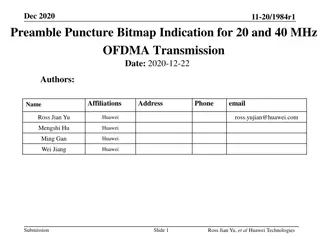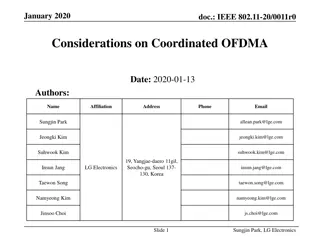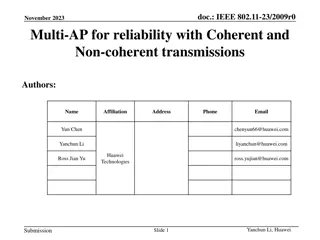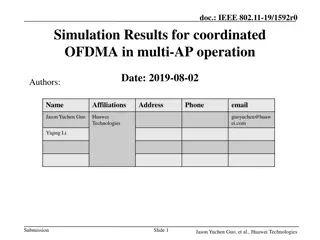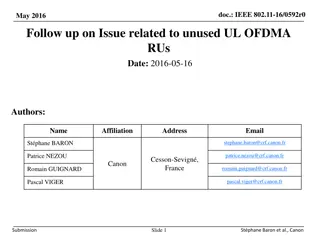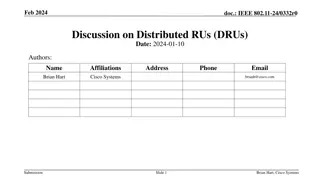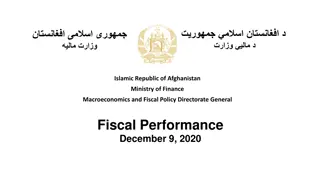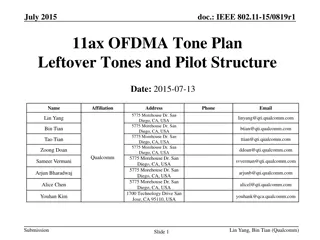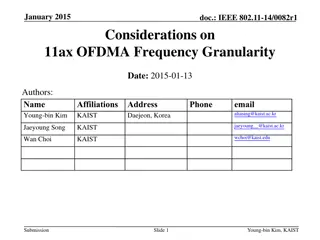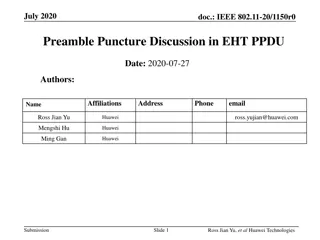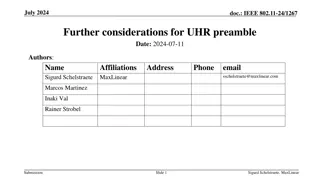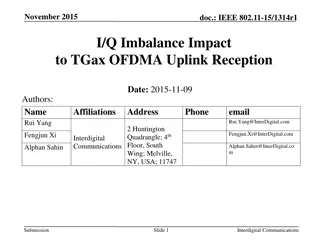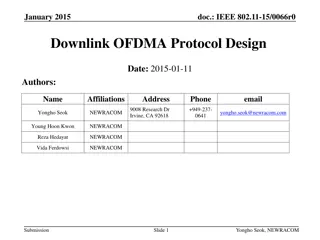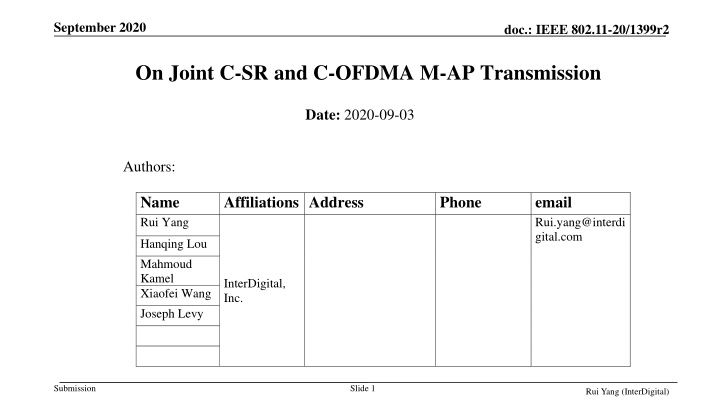
Enhancing Wireless Network Efficiency with C-SR and C-OFDMA
Explore the advantages of combining Coordinated Spatial Reuse (C-SR) with Coordinated Orthogonal Frequency Division Multiple Access (C-OFDMA) in IEEE 802.11 networks. Discover how these coordinated transmission schemes improve spectral efficiency in dense network environments by allowing multiple access points to coordinate their transmissions effectively.
Download Presentation

Please find below an Image/Link to download the presentation.
The content on the website is provided AS IS for your information and personal use only. It may not be sold, licensed, or shared on other websites without obtaining consent from the author. If you encounter any issues during the download, it is possible that the publisher has removed the file from their server.
You are allowed to download the files provided on this website for personal or commercial use, subject to the condition that they are used lawfully. All files are the property of their respective owners.
The content on the website is provided AS IS for your information and personal use only. It may not be sold, licensed, or shared on other websites without obtaining consent from the author.
E N D
Presentation Transcript
September 2020 doc.: IEEE 802.11-20/1399r2 On Joint C-SR and C-OFDMA M-AP Transmission Date: 2020-09-03 Authors: Name Rui Yang Affiliations Address Phone email Rui.yang@interdi gital.com Hanqing Lou Mahmoud Kamel Xiaofei Wang Joseph Levy InterDigital, Inc. Submission Slide 1 Rui Yang (InterDigital)
September 2020 doc.: IEEE 802.11-20/1399r2 Introduction Spatial reuse (SR) was introduced in 802.11ax Improving spectral efficiency in scenarios with highly dense networks A passive scheme, based on RSSI measurement of OBSS signals TGbe has agreed on multiple M-AP coordinated transmission schemes Coordinated spatial reuse (C-SR) operation [Motion 123] Coordinated OFDMA (C-OFDMA) [Motion 60] Coordinated Beamforming (C-BF) [Motion 112] Joint Transmission (JT) [Motion 111] In this contribution we discuss the benefit of using C-SR jointly with other coordination scheme, e.g., C-OFDMA Submission Slide 2 Rui Yang (InterDigital)
September 2020 doc.: IEEE 802.11-20/1399r2 Spatial Reuse in Coordinated M-AP There have been multiple contributions on coordinated spatial reuse [1-4] Provide basic ideas for actively reusing the RF spectrum with manageable interference Require measurements (e.g., RSSI) within and across BSSs Require synchronized exchange of those measurements among APs in an AP candidate set Similarity with other M-AP coordination schemes Measurement exchange among APs Synchronized/organized operation within a TXOP Among M-AP coordination schemes, C-SR can be viewed as part of other schemes Given the availability of connections among APs, it can be jointly deployed with other schemes E.g., Coordinated beamforming/null steering [20/0091r7] and C-OFDMA (this contribution) Submission Slide 3 Rui Yang (InterDigital)
September 2020 doc.: IEEE 802.11-20/1399r2 C-OFDMA with C-SR In the basic C-OFDMA, if a sub-channel (or an RU) is occupied by one AP, other APs in the AP candidate set can t use it to maintain perfect orthogonality in frequency domain zero inter- BSS interference However, perfect zero interference is not necessary, as long as certain SNR level can be achieved for a desired MCS level, which provides opportunity for spatial reuse In M-AP scenario, the SR coverage of APs may have many different pattens in terms of number of (or which) other APs that can transmit at the same time (See figures on the right) Depending on Tx power, required MCS level, relative distances among APs, RF radiation pattern etc. Spatially reusable area can be very large Therefore, when C-OFDMA is enabled, combining it with SR could enhance overall system throughput performance sr = x means x other APs can Tx at the same time AP Tx power = 20dBm AWGN only, PL model [5] o o o Submission Slide 4 Rui Yang (InterDigital)
September 2020 doc.: IEEE 802.11-20/1399r2 System Level Simulation Simulation setup [5] Scenario: Office space 4 APs on 3m high ceiling Tx power from each AP: 20dBm, omni directional Pathloss model PL(d) = 40.05 + 20*log10(fc/2.4) + 20*log10(min(d,10)) + (d>10) * 35*log10(d/10) fc = 5GHz AWGN channel, NF = 7 dB Total 80MHz channel bandwidth with 4 20MHz RUs DL transmission Assumptions Traffic Type: Full Buffer A scheduler manages resource usage @ the sharing AP Each AP randomly selects 2 associated STAs before scheduling 80MHz RU RU RU RU 20MHz Submission Slide 5 Rui Yang (InterDigital)
September 2020 doc.: IEEE 802.11-20/1399r2 System Level Simulation (cont.) Resource Allocation for all STAs From AP1 CH1 CH2 CH3 CH4 Assumptions (cont.) Shared APs provide the sharing AP with, for each STA-AP pair RSSI (or SNR) measurements Or RSSI or SNR ? ? ??? ?? Full scheduling information is sent back to all shared APs RU allocation for all STAs STA11 1 0 1 0 AP1 STA21 1 1 0 0 STA32 1 0 1 1 Sharing AP Shared AP AP3 AP2 Visible APs (0 or 1) Or SNR-per-STA from visible APs From AP3 AP1 AP2 AP3 From AP2 AP1 AP2 AP3 STA31 1 (or SNR311) 0 1 (or SNR313) STA21 1 (or SNR211) 1 (or SNR212) 1 (or SNR213) STA32 1 (or SNR321) 1 (or SNR322) 1 (or SNR323) STA22 0 1 (or SNR222) 1 (or SNR223) Notation: STA21: The 1st STA associated to AP2. SNR211: Measured SNR at STA21 under the interference from AP1 only Submission Slide 6 Rui Yang (InterDigital)
September 2020 doc.: IEEE 802.11-20/1399r2 Scheduling Algorithms Two methods used in the simulation Optimal Method Consider all possible SR patterns, MCS levels and resource allocations Determining a SR pattern and resource allocation that maximize the sum rate, subject to One RU can be allocated to at most one STA within a BSS per PPDU A STA will not be scheduled with SR if the SINR is too low such that MCS0 cannot be achieved Integer programing technique can be used to find the solution Sub-optimal Method Based on received simple SR tables (contains logic 0 or 1 ) from shared APs Determine resource allocation schemes for a moderate MCS level (e.g., MCS4) which can be a trade-off between pure SR and pure OFDMA For both methods, each shared AP determines the MCS for its own associated STA using the scheduling table received from sharing AP Submission Slide 7 Rui Yang (InterDigital)
September 2020 doc.: IEEE 802.11-20/1399r2 Simulation Results In C-OFDMA case, all STAs can use MCS9 in this example Up to 25% improvement in total throughput (@median) if C-SR is added on top of C-OFDMA Sub-optimal solution (low overhead) can also provide improvement (~12% @median) Limited measurements and feedback Submission Slide 8 Rui Yang (InterDigital)
September 2020 doc.: IEEE 802.11-20/1399r2 Summary C-SR can be considered as part of other coordinated Tx schemes in M-AP framework Joint C-SR and C-OFDMA can improved overall system throughput and spectral efficiency Submission Slide 9 Rui Yang (InterDigital)
September 2020 doc.: IEEE 802.11-20/1399r2 References [1] 11-20/0576r1, Coordinated Spatial Reuse Protocol [2] 11-20/0410r4, Coordinated Spatial Reuse Procedure [3] 11-20/0457r1, Discussion on Coordinated Spatial Reuse Operation [4] 11-20/0107r1, Multi-AP coordination for spatial reuse [5] 11-14/0980r16, Simulation Scenarios Submission Slide 10 Rui Yang (InterDigital)

